Herbie Hancock: Crossings (Speakers Corner)
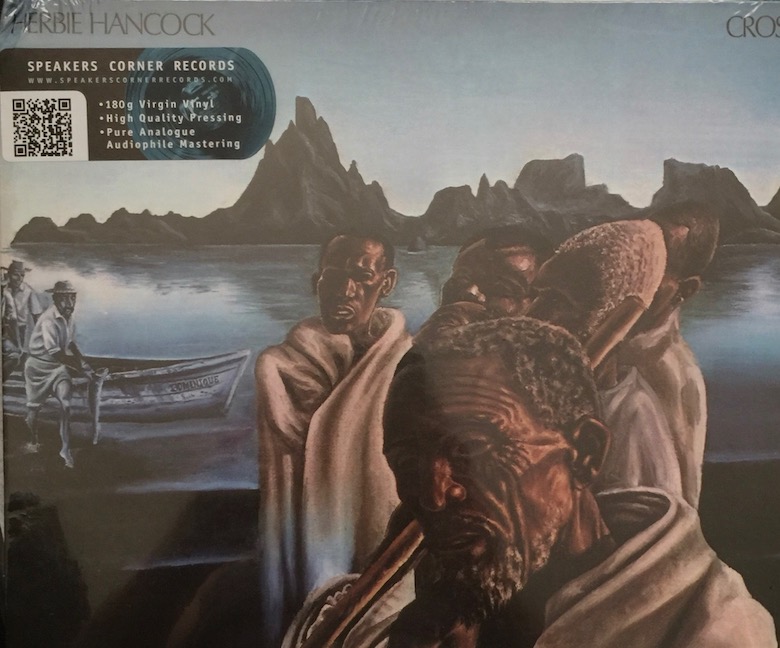
There are so many good reasons to own a copy of this record, not the least being that it is a sonic treat. But there are other just as compelling reasons: it is jazz tinged fusion mixed with psych, funk and spacy sounds that reflect a unique, and perhaps most adventurous period in Hancock’s growth as an artist; it is highly experimental but embraces so much of what came before that it is a virtual primer of jazz sounds that are both eerily strange and strangely familiar; it is performed by a stellar band that includes Buster Williams on bass, Billy Hart on drums, Julian Priester, Bennie Maupin and Eddie Henderson on horns and woodwinds and synth sounds from Patrick Gleason. The band, known as the Mwandishi band (the word means, variously, “author”, “reporter” or “scribe” in Swahili), delivered three albums—Crossings being the second—with this line-up. It was also the last album by Hancock for Warner Brothers; Sextant, the last part of the trilogy, was delivered to Columbia Records.
Background
Though the record is highly regarded among jazz and fusion fans, it was avowedly not “commercial.” Despite Warner’s acumen in signing, developing and marketing an eclectic array of modern artists in this era, this otherwise savvy record company completely missed the mark. According to Nick Di Maria, who studied under Eddie Henderson, the Mwandishi’s band’s trumpeter and wrote his master’s thesis on the trilogy:
[Warner Bros.] were unaware, and could not fully grasp that the album should be exposed to the jazz and the rock/pop markets and problematically issued the release alongside easy listening and adult markets. In an April 1972 advertisement for Sam Goody, Crossings could be found next to Arlo Guthrie’s Hobo’s Lullaby and Randy Newman’s Sail Away. Jazz fans would not think to look, and fans of easy listening would not consider Herbie Hancock.[1]
The album nonetheless developed a following. It is now regarded as an “important” record but don’t let that get in the way. Its lack of “commercial potential” at the time of release simply failed to recognize the jazz aficionados, fusion fans and other, more adventurous listeners who would grow to love it. Today, it can be appreciated for pulling together a wide array of jazz styles and playing techniques that still sound fresh and timeless.
It is also a milestone in Hancock’s transition from the Miles Davis era; after Hancock completed the Mwandishi trilogy,[2] he moved on, to Columbia Records- with Head Hunters, a multi-platinum album that brought him into every home. The band continued, the line up changed and Hancock returned to sit in on occasion, but the three albums – Mwandishi, Crossings and Sextant –were, according to Di Maria “at the apex of jazz in the 1970’s, both musically and culturally, and left one of the most significant footprints that still resonates to this day.” Id. at note 1.
The Copies
Finding a good playing copy of Crossings was no easy task. “Oh sure, that’s a common record, but I don’t have it,” said more than one dealer. None of the Brooklyn dealers on my used record tour last summer had a copy. Most of the online listings at the time were graded below my standards. That’s not a good starting place.
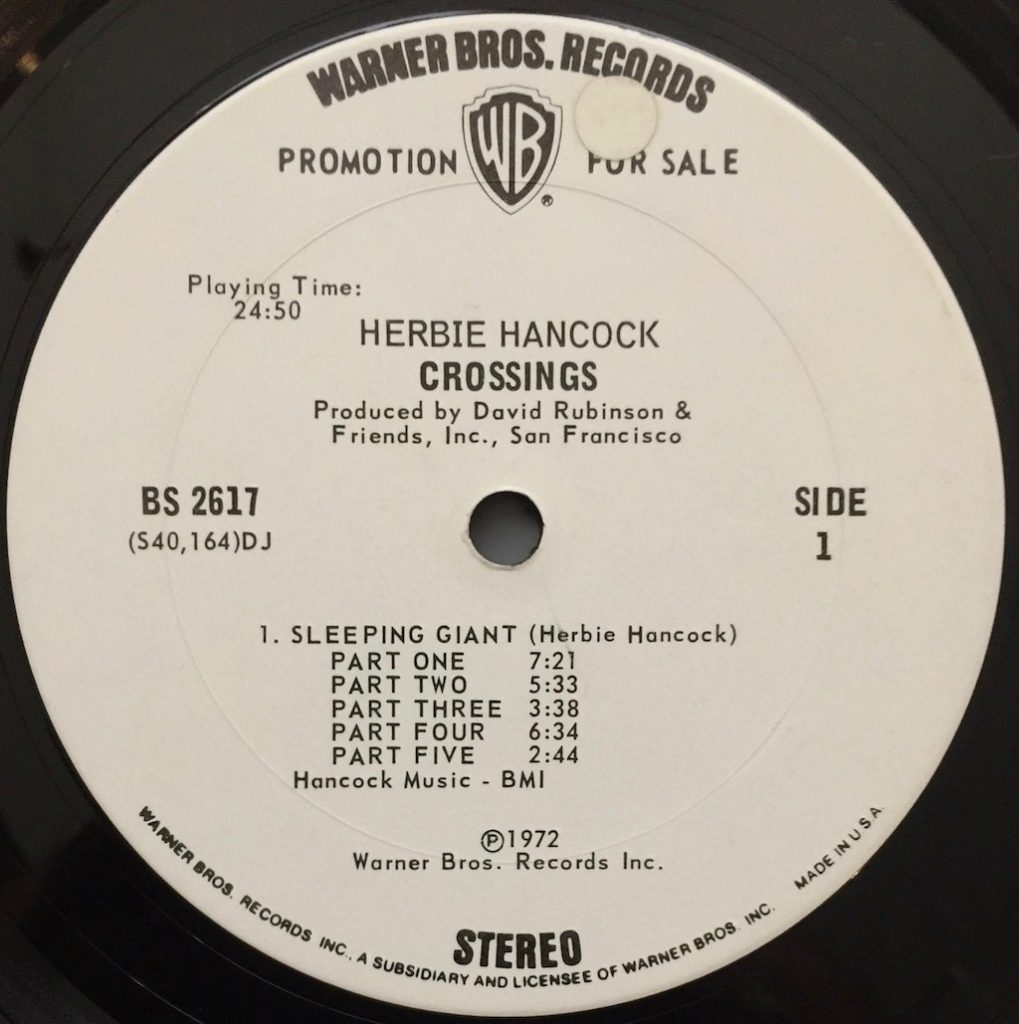
The WLP I eventually found online had considerable noise, despite my usual heroic cleaning efforts. I eventually broke down and bought a sealed early copy from a dealer of such things- something I rarely do because sealed records fetch a premium for the very reason that scares me off- who knows what lurks under that tightly bound shrink wrap? I lucked out on this copy- it’s not so easy (or cheap) to find brand new old records that are truly un-played and aren’t warped or have other defects that you only discover after you’ve opened and played them.
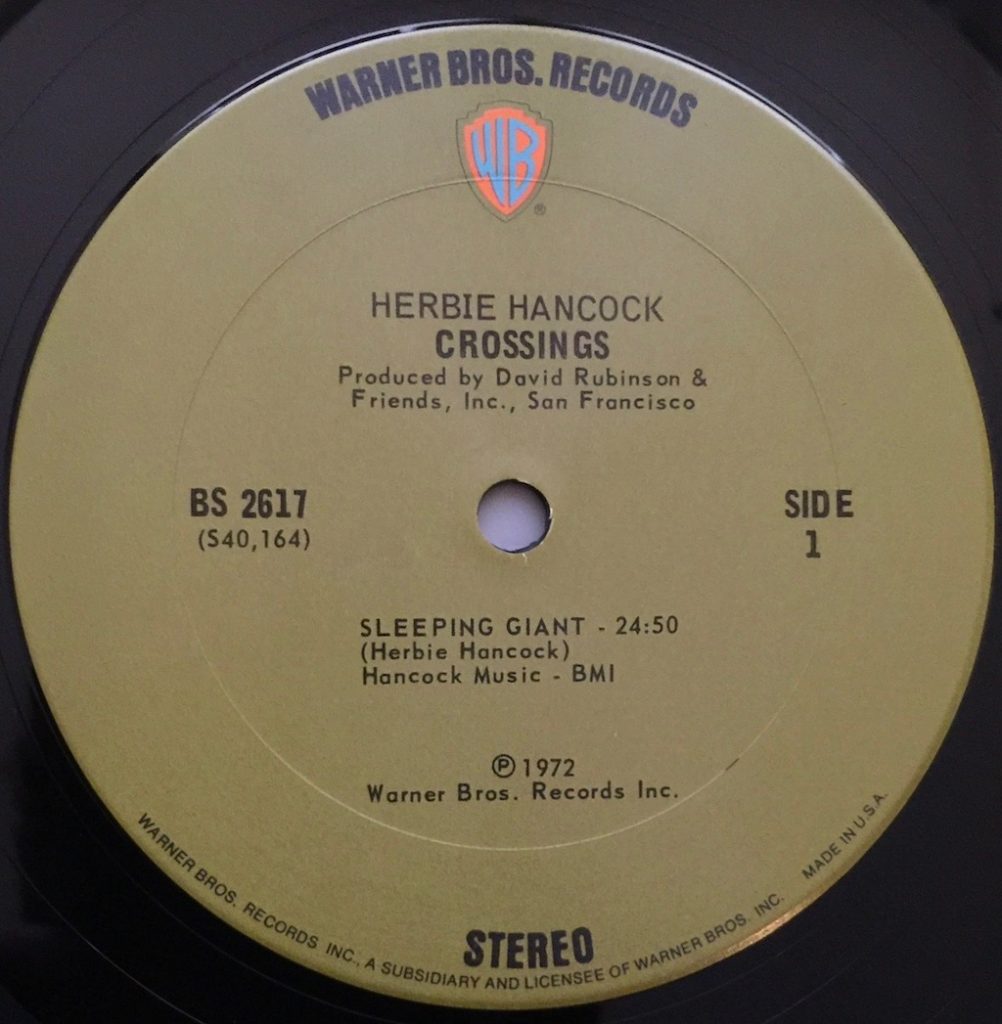
The “time capsule” green label that I bought still sealed-which became my listening copy last year
I caught wind of the fact that Speakers Corner was reissuing the record and reached out to ask for a copy. I was curious to see how it stacked up against my pristine early copy. Speakers Corner is a known quantity among audiophiles for its attention to the important stuff: analog sources, good mastering and good pressings, along with packaging that doesn’t detract from the original artwork on the jackets. The record, pressed at Pallas (usually impeccable) was mastered by Kevin Gray, whose re-masters are sought after by audiophiles and music hounds. The vinyl is heavier than the original U.S. pressing, but I could care less about that.
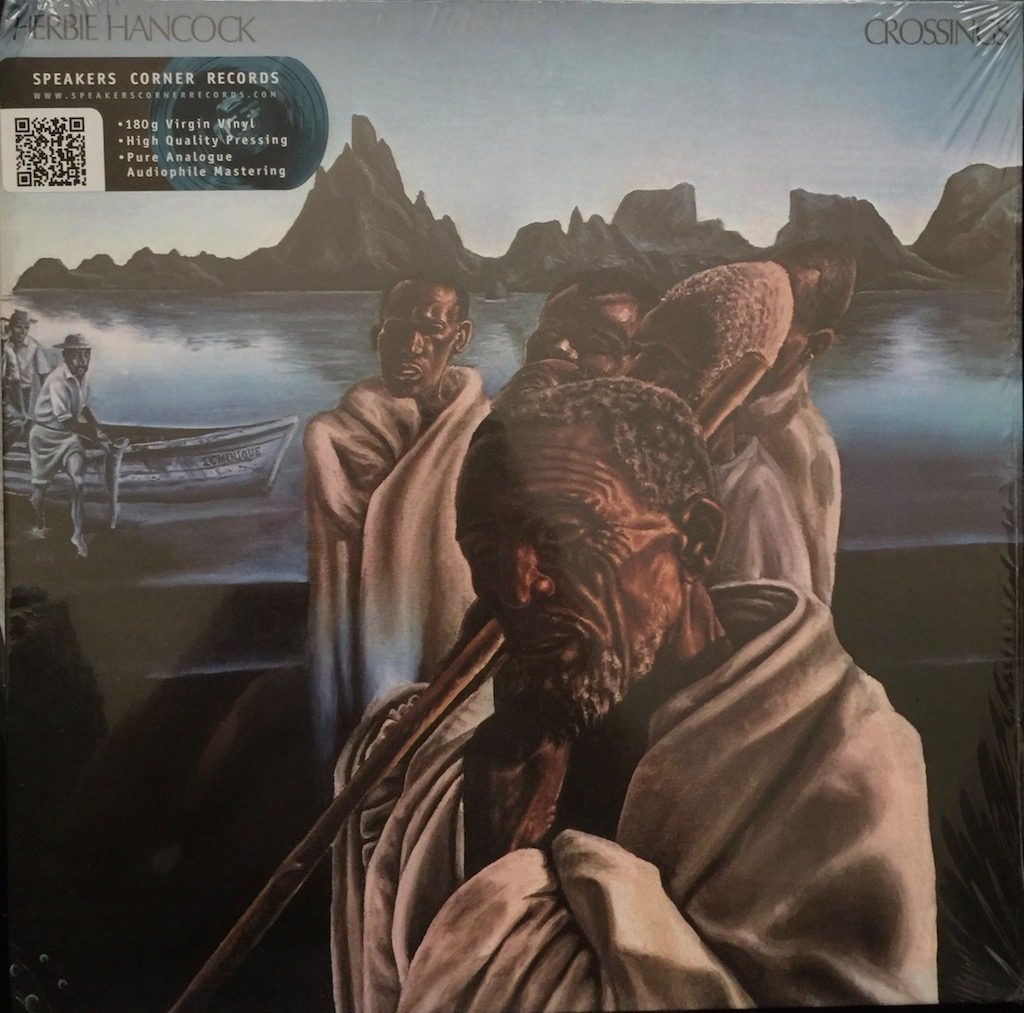
The Music
Just to set a baseline, the original U.S. pressing[3] on the Warner “green label” is a very good sounding record, and the music shows that off from the opening percussion beats.
A single composition, “Sleeping Giant,” occupies the entire first side. (The promo release breaks down each track within it and provides timings, ostensibly for radio play).
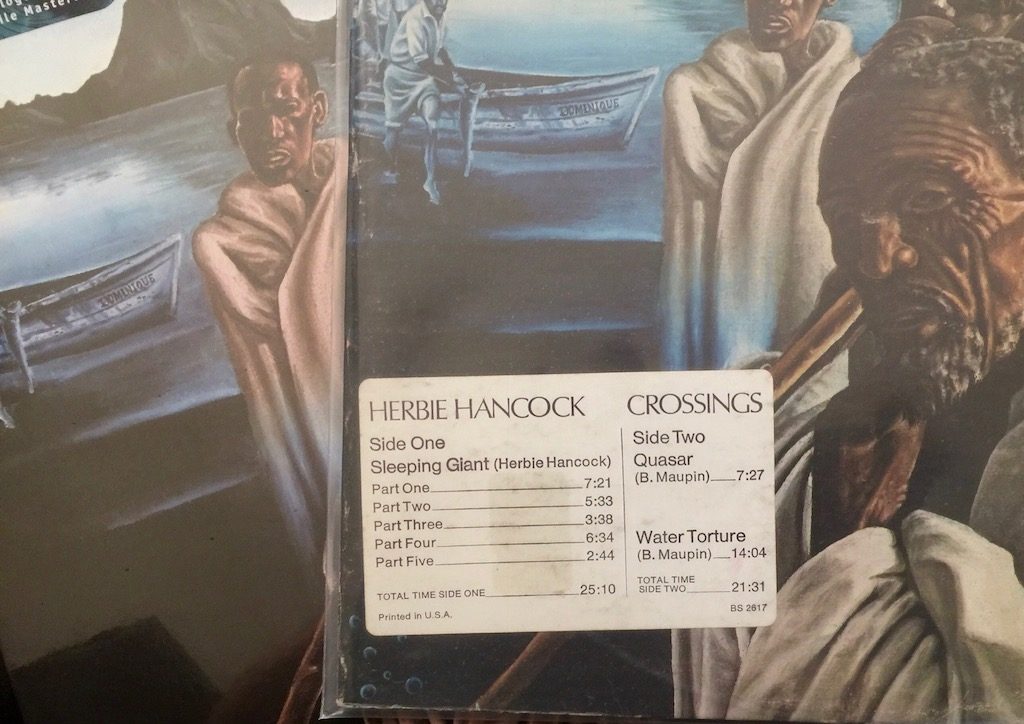
As the different percussion instruments enter and recede along with some spacy sounds, a muted cowbell (or hollow wood block) keeps constant count – and while the drums rattle on, emerging, receding and growing deeper, the Mellotron swells and discordant Rhodes piano notes jam against the bass line. It’s not cacophony though, but an organized frenzy; those funky piano notes set the stride and the bass guitar is not just maintaining pace but providing tone. After this mad whirl, all slows down to held notes, and the horns and woodwinds sway as the trumpet staccatos; then we shift into a true funk, wah-wah sounding groove, that bass is glorious, carrying the melody (with synth backing, or so it sounds); fade and transition again, to a cool jazz sound that lasts only briefly before we descend into funk again.
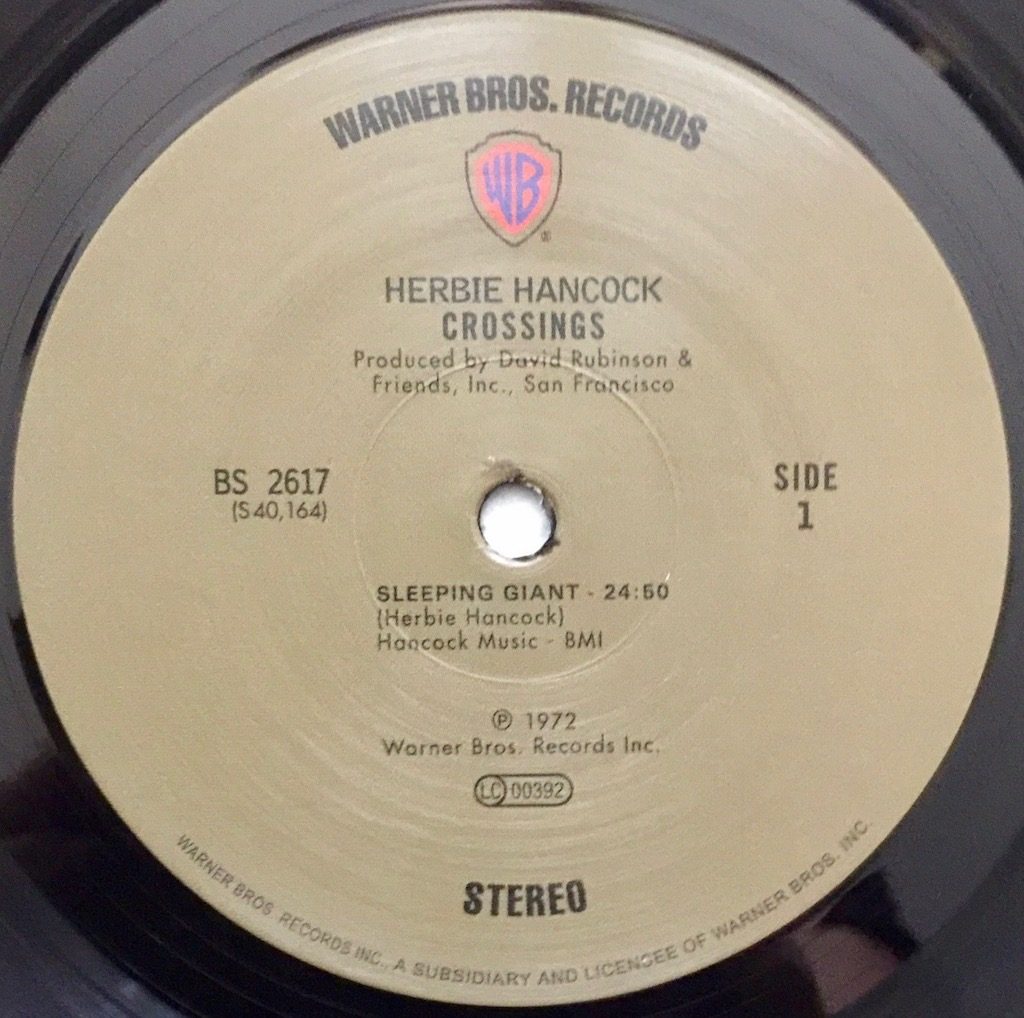
The Speakers Corner copy looks little different (apart from the LC Code) than the original U.S. green label shown above.
Though this is “Herbie’s” record, the band makes it so; these guys get into such a tight groove that they seem to move as one. The drums are just sensational, striking different tempi, and the cymbal rolls shimmer against the darker instrument tones. And there’s that bass, defining a counterpoint to the trumpet and sax; neither sound strident but both have a deliberately strained, almost plaintive sound. And off we go again, into another funky excursion, freed from the constraints of time or melody- this is now a driving groove and the horns are wailing. Everything makes sense, not a note out of place. And we slow down again, into a cool jazz vibe. There is much beauty here, but you can’t hold on to it, because it shape shifts, the snare strikes out a triplet and we’re in yet another territory- spacy, fleeting echoes of horn and jungle sounds recede toward silence.
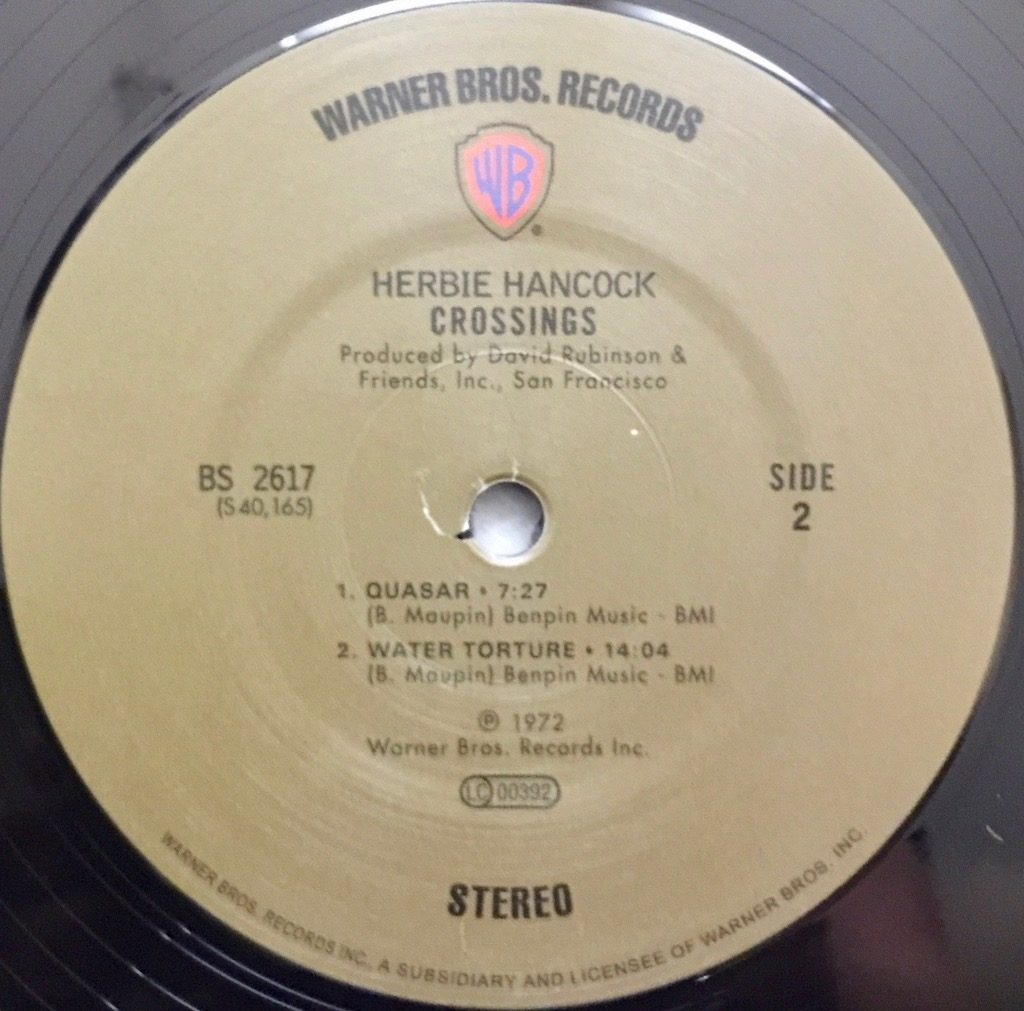
Side two- from the Speakers Corner copy which bears an “LC” Code-an international industry convention introduced after the original record, shown further above, was released.
Side two opens with “Quasar,” the sounds of a piano with real gravitas, bass, some synth scattered chirps and a sense that we are emerging from darkness into luminosity –abrupt drum hits, lovely woodwind interplay, a little echo on the cymbals, and the synth is grumbling. We are somewhere in uncharted space, but it’s not drifting or aimless: cool lines set a frame for the various instruments to flare, the horns call and respond, drilling down, trilling up, and there’s that cowbell/woodblock again, counting time. Suddenly, it’s a jazz club groove, and then the synth growls, the horns growing fainter.
“Water Torture” completes the side. It’s not really an Eastern motif, you hear sounds almost like a hyena snickering, and the clock count tells us a beat is coming. Oh, yeah, the bass drives us into jazzy territory- wisps of sound, snicks of percussion pulled off the high hat like vapor, and there’s some inner conversation growing—as the instruments huddle, and return to that familiar groove. It’s a good one, one you want more of; a flare of the horns and we’re going somewhere else. The bass redefines the destination, and a kazoo sound (synth?) leads us to yet another path, of horn, piano funk, spare drum hits and a spell of see-saw, almost carnival like interplay as an interlude, and we come back to one of those lovely, funky grooves that eventually breaks down, the pieces falling apart slowly as a string tone holds taut, some shimmer and we space out.
Comparison of Pressings
The Speakers Corner is clear, dynamic and articulate, without a trace of bite, nice deep bass and oh, those snare rattles and drum head tone.
By comparison:
“Sleeping Giant” on the original Warner is all there, flawlessly, but it is more polite. Not that the Speakers Corner sounds aggressive or the early pressing rolling off or muffled. It’s just a noticeably different presentation, with the Speakers Corner sounding far more articulate and punchy. The Speaker Corner sounds “clearer” in a good way. (I’m listening to horn type loudspeakers so too much “clear” is often not a good thing if you think horn speakers tend toward the shouty; mine don’t, but they are mollified by a pair of Lamm ML2 amps, freshly re-tubed by Vlad with a nice pair of NOS Tele ribbed plates in the 12AX7 slot).
You don’t get the deep bite/growl of the synth on the Warner in the same way you do on the Speakers Corner.
“Quasar” is stunning on the original pressing, but it sounds more restrained; the drums and other percussion instruments don’t “pop” the way they do on the Speaker Corner re-master.
On “Water Torture,” the original pressing sounds smoother, a little more compressed in places but tonally somewhat warmer. Sometimes the horns have a little edge, not unnatural for a real horn live; the drums and cymbals don’t seem to extend as high, but what’s there is extremely good sounding. You wouldn’t believe you were missing something unless you compared it to the Speakers Corner, which seems to provide more of everything.
I did some off the cuff “db” checks using a little handheld meter (nothing fancy) and both records are roughly in the same loudness range on average; yet the Speakers Corner sounds far more dynamic.
If this were some massed string classical piece where I was looking for tone and warmth, I might lean a little more toward the original pressing. But, for this recording, this music, and these sounds, I don’t think this is a difficult choice: the Speakers Corner is going to grab you in a way that the original Warner green label won’t. (And I have a very high regard for those old green labels- they were some of the most consistently good sounding major label records from the early ‘70s).[4] Add to that, even if you wanted the more polite, perhaps slightly warmer, more tonally cozy aspect of the early Warner, you are going to have a devil of a time finding one in the kind of condition mine is. Like close to impossible. And, even if someone served you up a new old stock copy, unmolested for the same price as the Speakers Corner, I would have chosen the Speakers Corner re-do. And saved some real money to boot. (Regular readers know I have few qualms[5] about recommending expensive older records when they are demonstrably better). But that isn’t the case here. You could search for quite a while to find a truly dead mint original pressing. I did. And I’d still choose the Speakers Corner, which is cheaper by a considerable margin, with zero hunting effort.
Kudos to Kevin Gray and the folks at Speakers Corner for this one. Killer.
Bill Hart
Austin, TX.
Sept. 2017
____________________________________________________________________________________________________
[1] See https://nickdimaria.wordpress.com/2014/05/16/my-masters-thesis-on-herbie-hancocks-mwandishi-band/ Nick is an educator in New Haven and an active part of the New England jazz scene who released his third studio album, Time Circuit, in 2015 and will be releasing a live album in 2017. Nick’s blog home page is https://nickdimaria.wordpress.com.
[2] I have seen references to Fat Albert Rotunda as part of the Mwandishi cycle, but I think that was due more to Warner’s after the fact marketing. See https://www.discogs.com/Herbie-Hancock-Mwandishi-The-Complete-Warner-Bros-Recordings/release/8566474
The “Fat Albert” record tied into a Bill Cosby animated television program that led to Hancock’s introduction to the Warner label.
[3] For reference, my playing copy is a hand inscribed 1A/1B with a backwards “S” faintly etched into the dead wax. The WLP, which I did not use for listening comparisons, shows A1A /B1A hand inscribed with an additional “DJ” notation on both sides and a backward “S” only on side 1. I would consider the Warner green label “playing copy” to be truly “mint” and suffering no previous playing damage or groove wear. In other words, the standard for comparison purposes here was truly a “time capsule” copy, likely pressed for Warner at Columbia’s Santa Maria plant.
[4] See The Warner Green Label (And Beyond)
[5] It still makes me uneasy, sometimes, when old pressings reach well into the three and now four figure territory. Then it becomes a question of sonic trade-offs, leaving aside collectability, to find a decent reissue that will satisfy. There is no such trade off here, however, since the Speakers Corner betters the original in almost all respects.
Leave a Reply
You must be logged in to post a comment.